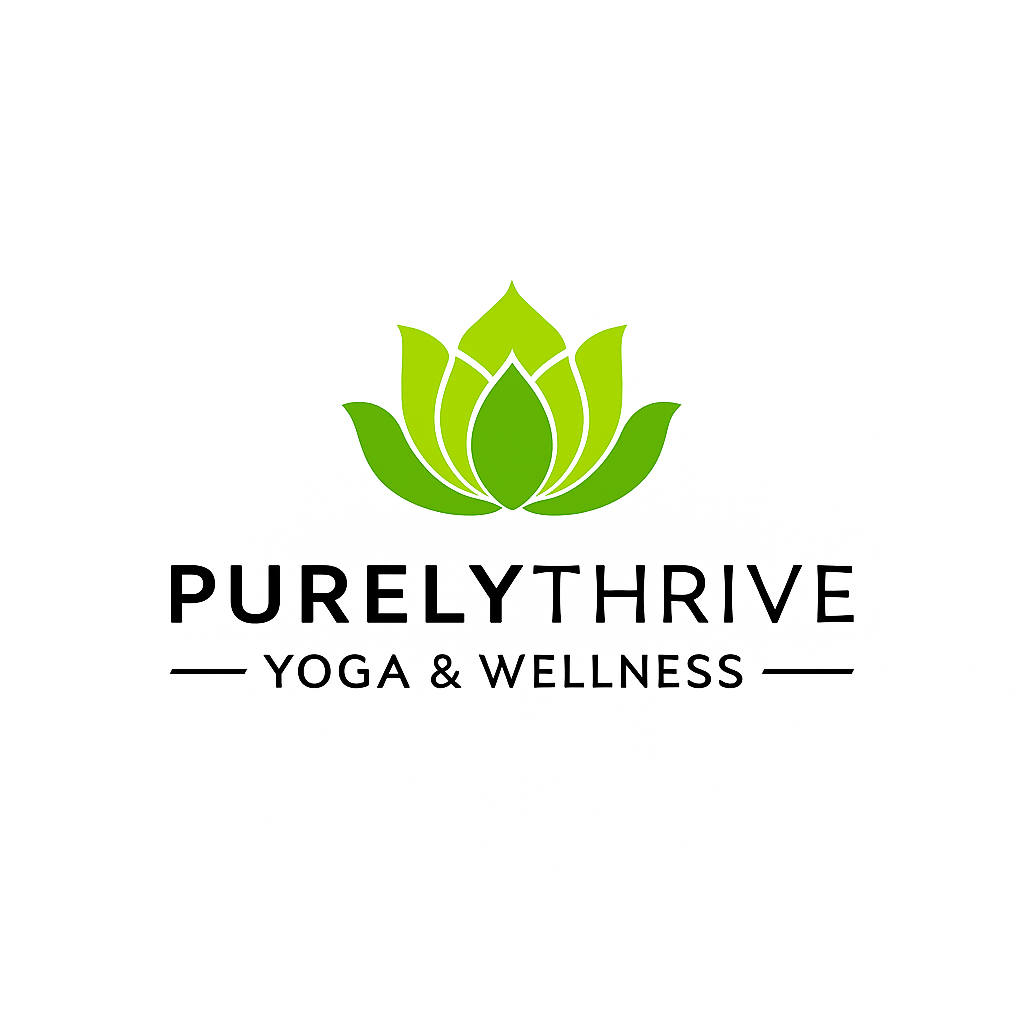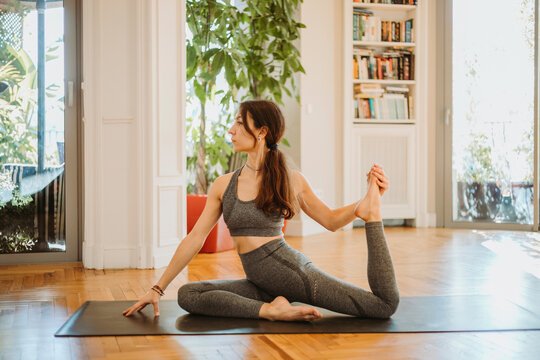
When thoughts spin out of control and worry takes over, many people feel trapped in their own minds. Anxiety and overthinking create a cycle that steals peace and makes daily life feel overwhelming. The racing thoughts, the endless “what if” scenarios, and the physical tension that comes with mental stress can leave anyone feeling exhausted.
Yoga offers a proven way to break free from this cycle by calming both the mind and body through specific poses, breathing techniques, and mindful movement. Research shows that yoga helps slow down hyperactive brain networks and reduces stress hormones that fuel anxious thoughts. Unlike quick fixes that only mask the problem, yoga addresses the root causes of mental chatter.
The good news is that you don’t need hours of practice to see results. Simple poses, gentle breathing exercises, and short routines can help quiet an overactive mind and bring back a sense of calm. Whether someone is new to yoga or has been practicing for years, there are specific techniques that work especially well for managing anxiety and stopping the overthinking loop.
Key Takeaways
- Yoga calms anxiety by resetting the nervous system and slowing down overactive brain networks that cause racing thoughts
- Specific poses and breathing techniques can quickly interrupt the cycle of overthinking and bring the mind back to the present moment
- A consistent yoga routine with gentle movements and relaxation practices builds long-term resilience against stress and mental overwhelm
How Yoga Calms Anxiety and Overthinking
Yoga works by changing how the brain and body respond to stress through three key pathways. It quiets overactive mental networks, activates the body’s natural relaxation response, and trains attention to stay focused on the present moment.
The Science Behind Mental Chatter
When someone feels anxious or starts overthinking, specific brain networks become overactive. The Default Mode Network is the main culprit behind mental chatter.
This brain system turns on when a person isn’t focused on a task. It creates the endless loop of worries and “what if” thoughts that fuel anxiety.
The amygdala also plays a big role. This part of the brain acts like a smoke alarm for danger. In people who overthink, it becomes too sensitive and sounds false alarms.
Key brain changes in overthinking:
- Default Mode Network works overtime
- Amygdala stays on high alert
- Stress hormones like cortisol increase
- Mental tension builds up
Research shows that yoga helps calm these overactive brain areas. Slow breathing and gentle movements tell the Default Mode Network to quiet down. This breaks the cycle of repetitive thoughts that create anxiety.
Yoga’s Effect on the Nervous System
Yoga directly activates the parasympathetic nervous system. This is the body’s “rest and digest” mode that promotes calm and healing.
Many yoga poses stimulate the vagus nerve. This important nerve connects the brain to major organs and controls the relaxation response.
When the vagus nerve gets activated, several things happen:
- Heart rate slows down
- Blood pressure drops
- Stress hormones decrease
- Mental clarity improves
Breathing techniques are especially powerful. Slow, deep breaths send signals to the brain that it’s safe to relax. This helps reduce both physical tension and mental stress.
Forward folds and gentle inversions also help. These poses encourage blood flow to the brain while creating a sense of safety and protection.
Cultivating Mindfulness and Presence
Yoga teaches people to focus on physical sensations instead of racing thoughts. This skill is called interoception – awareness of what’s happening inside the body.
During yoga practice, attention shifts to the breath, muscle sensations, and body position. This pulls focus away from anxious thoughts and into the present moment.
Mindfulness practices in yoga include:
- Feeling the breath move in and out
- Noticing how poses affect the body
- Observing thoughts without getting caught up in them
- Staying aware of physical sensations
This type of focused attention rewires the brain over time. Regular practice makes it easier to catch overthinking before it spirals out of control.
The present moment becomes a safe place to return to when anxiety starts building. Instead of getting lost in mental chatter, people learn to ground themselves in their physical experience.
For help with breathing practices and meditation, we at Purely Thrive recommend eye pillows to help focus on your breath and movement.
Essential Yoga Poses for Reducing Anxiety and Overthinking
These four calming asanas help quiet racing thoughts by combining gentle stretches with focused breathing. Each pose works to release physical tension while bringing attention to the present moment.
Child’s Pose (Balasana)
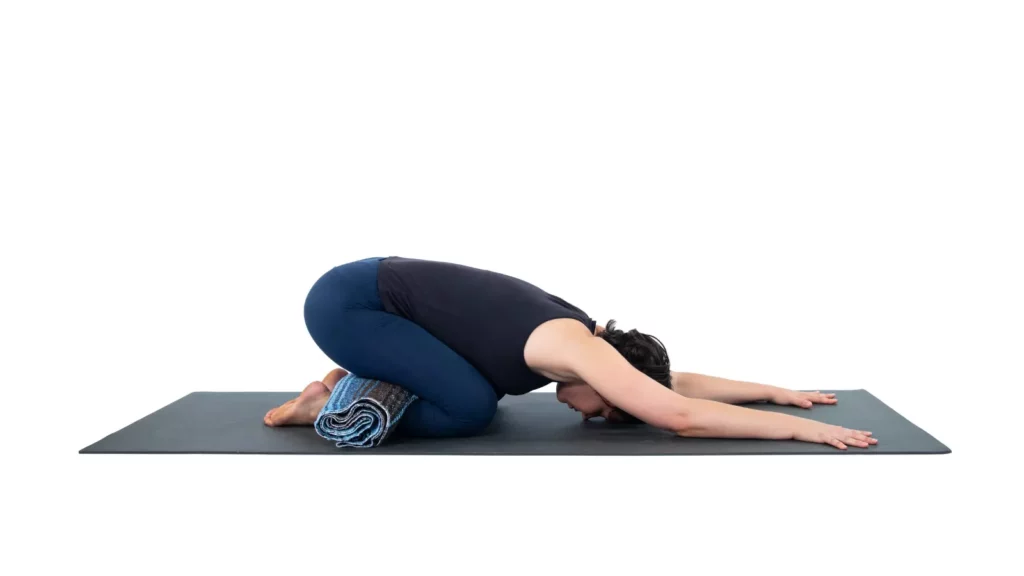
Child’s pose is one of the most soothing yoga poses for anxious minds. This gentle resting position creates a sense of safety and helps people turn their focus inward.
To practice balasana, a person kneels on the floor or mat and sits back on their heels. They then fold forward, bringing their forehead to the ground while extending their arms in front of them or alongside their body.
Benefits for anxiety:
- Calms the nervous system
- Reduces stress hormones
- Creates a feeling of protection
- Slows down racing thoughts
The pose works by activating the body’s rest response. When someone folds forward, their heart rate naturally slows down. This physical change signals the brain to relax.
People can stay in child’s pose for 1-5 minutes. Those with knee problems can place a pillow between their thighs and calves for comfort.
Standing Forward Bend (Uttanasana)
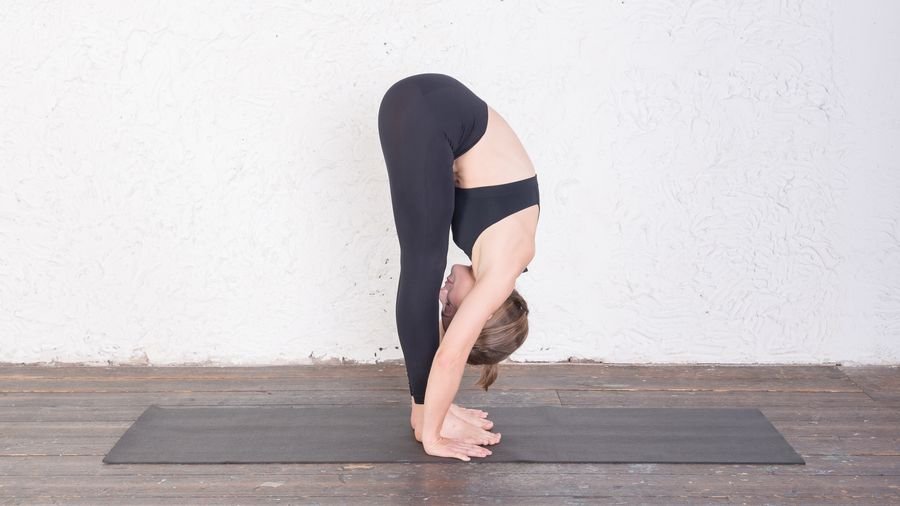
Standing forward bend helps release tension in the back and neck while calming an overactive mind. This pose allows fresh blood to flow to the brain, which can help clear mental fog.
To perform uttanasana, a person stands with feet hip-width apart. They slowly fold forward from the hips, letting their arms hang toward the ground. The knees can bend slightly for comfort.
Physical benefits:
- Releases tight hamstrings
- Relieves back tension
- Improves circulation
- Stretches the spine
Mental benefits:
- Quiets mental chatter
- Promotes introspection
- Reduces stress levels
The inward focus of this pose naturally draws attention away from anxious thoughts. People often find their breathing deepens automatically in this position.
Beginners can rest their hands on their shins or use blocks under their palms. The pose should be held for 30 seconds to 1 minute.
Seated Forward Bend (Paschimottanasana)
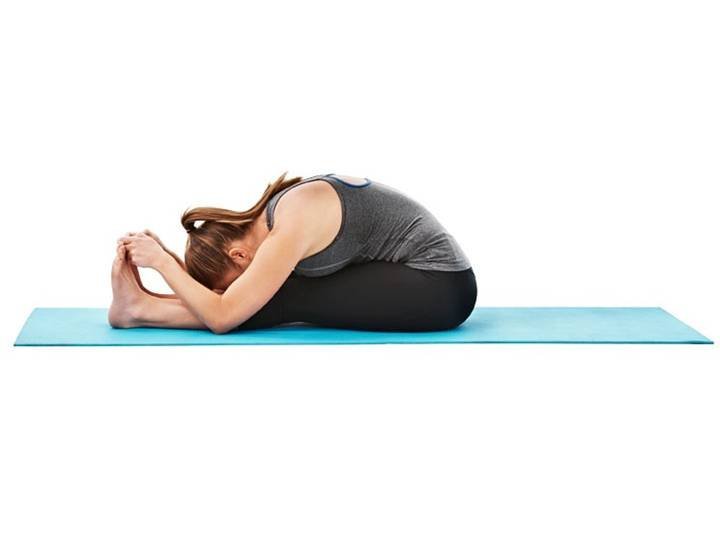
Seated forward bend creates a calming effect on the nervous system. This pose combines the benefits of forward folding with the grounding feeling of sitting on the earth.
A person sits with legs extended straight in front of them. They slowly fold forward over their legs, reaching for their feet or shins. The spine should stay long rather than rounded.
Key muscles worked:
- Hamstrings
- Spinal extensors
- Gastrocnemius
The pose helps reduce anxiety by encouraging slow, deep breathing. As someone folds forward, they naturally breathe into their back body, which activates calming nerve pathways.
This asana also promotes patience and acceptance. Many people cannot reach their toes at first, which teaches them to work with their current abilities rather than forcing results.
People with tight hamstrings can sit on a blanket or bend their knees slightly. The focus should be on the breath rather than how deep the fold goes.
Bridge Pose (Setu Bandhasana)
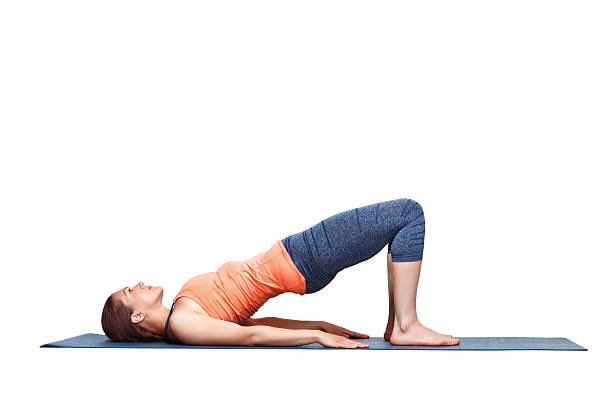
Bridge pose opens the chest and heart while strengthening the back body. This gentle backbend can help lift mood and counter the forward slumping that often comes with anxiety.
To practice setu bandhasana, a person lies on their back with knees bent and feet flat on the floor. They press down through their feet and lift their hips toward the ceiling.
Benefits include:
- Opens tight chest muscles
- Strengthens glutes and hamstrings
- Improves posture
- Energizes while calming
The heart-opening aspect of bridge pose can help people feel more confident and less withdrawn. When the chest opens, breathing becomes easier and fuller.
This pose also grounds people through their feet and shoulders while lifting the heart. This combination helps create stability while opening to new possibilities.
People can hold bridge pose for 30 seconds to 1 minute. Those who want more support can place a block between their thighs or under their lower back.
Breathing Techniques and Deep-Relaxation Practices
These pranayama exercises and restorative poses help calm the nervous system and quiet mental chatter. They work by balancing prana energy and activating the body’s natural relaxation response.
Nadi Shodhana (Alternate Nostril Breathing)
Alternate nostril breathing is one of the most effective pranayama techniques for reducing anxiety and overthinking. This practice balances the left and right sides of the brain while calming the nervous system.
How to practice:
- Sit comfortably with the spine straight
- Use the right thumb to close the right nostril
- Inhale through the left nostril for 4 counts
- Close both nostrils briefly at the top of the breath
- Release the thumb and exhale through the right nostril for 4 counts
- Inhale through the right nostril
- Close both nostrils again
- Release the left nostril and exhale
Practice for 5-10 minutes daily. This technique helps clear energetic pathways called nadis and brings mental clarity.
The rhythmic pattern creates a meditative state that interrupts anxious thought loops. Many people notice reduced stress levels after just a few rounds.
Viparita Karani (Legs-Up-the-Wall Pose)
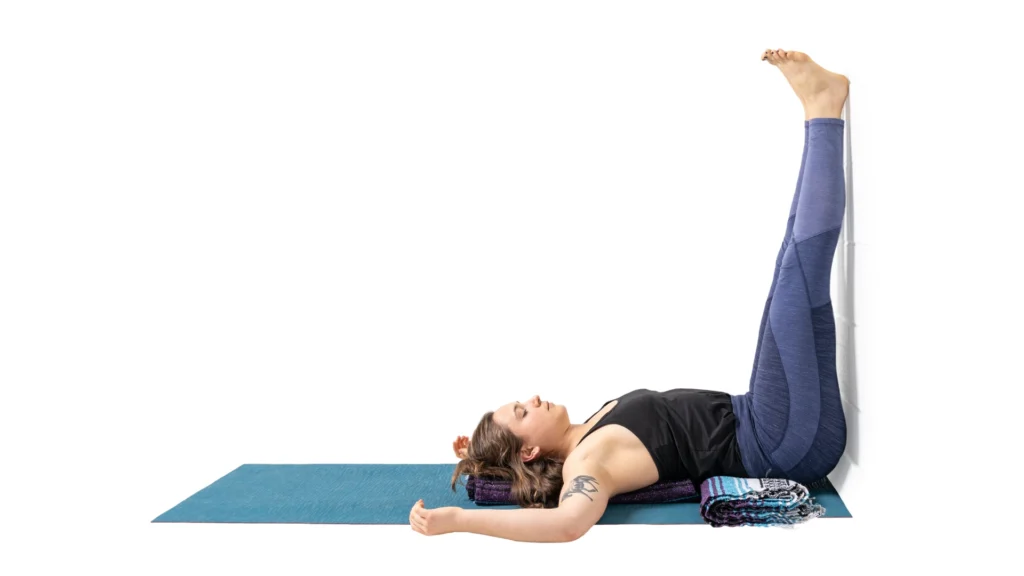
Viparita karani is a gentle inversion that promotes deep relaxation without requiring flexibility or strength. This pose helps shift the nervous system into rest mode.
Setup instructions:
- Lie on the floor near a wall
- Scoot the hips close to the wall base
- Extend legs up the wall
- Rest arms by the sides with palms facing up
- Place a folded blanket under the lower back if needed
Hold the pose for 10-20 minutes while breathing naturally. The gentle inversion helps blood flow back to the heart and brain.
This position activates the parasympathetic nervous system. It reduces cortisol levels and helps quiet racing thoughts.
The pose is especially helpful before bedtime. It signals to the body that it’s time to wind down and relax.
Savasana (Corpse Pose)
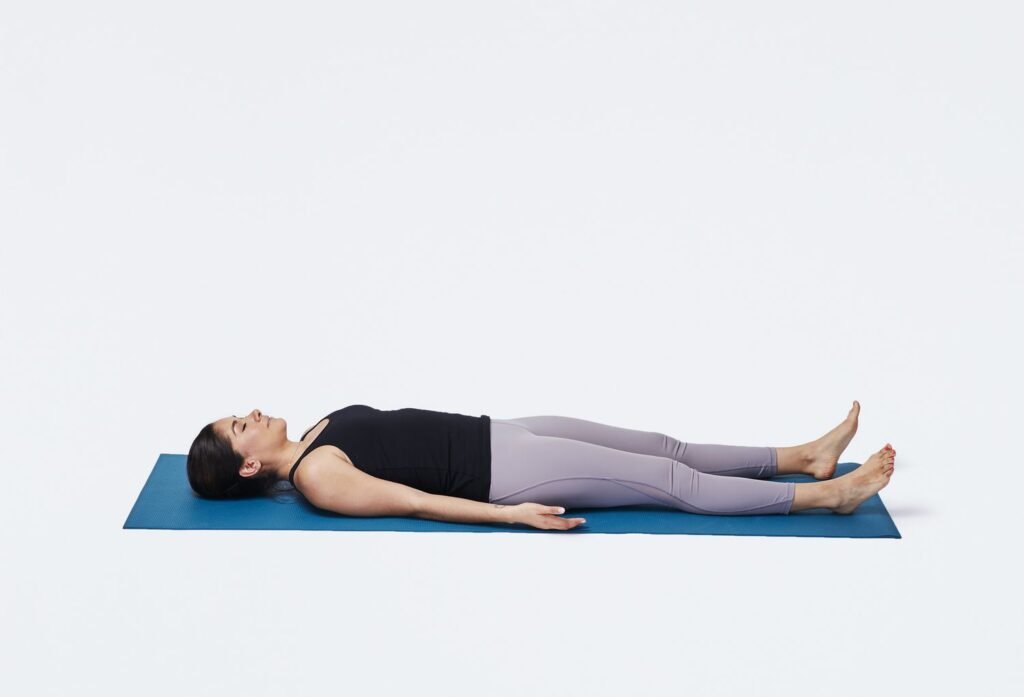
Savasana appears simple but requires mental discipline to achieve complete relaxation. This final resting pose helps integrate the benefits of breathing practices.
Proper alignment:
- Lie flat on the back with legs slightly apart
- Let arms rest away from the body with palms up
- Close the eyes and soften the facial muscles
- Allow the breath to return to its natural rhythm
Begin with a body scan, releasing tension from head to toe. Notice each part of the body and consciously let it relax.
Focus on the natural breath without trying to control it. If thoughts arise, gently return attention to the breath or body sensations.
Practice savasana for 10-15 minutes after breathing exercises. This allows the nervous system to fully absorb the calming effects of pranayama practice.
The pose teaches the mind to let go of mental activity. Regular practice builds the ability to find stillness even during stressful situations.
Building a Yoga Routine for Lasting Calm
A consistent yoga practice helps train the nervous system to find calm more quickly during stressful moments. Mindfulness extends beyond the mat into daily activities, while specific techniques help chronic overthinkers break mental loops and build lasting peace.
Practicing Mindfulness On and Off the Mat
Mindfulness in yoga starts with paying attention to breath and body sensations during poses. This awareness creates a foundation for staying present throughout the day.
On the Mat:
- Focus on breathing patterns during each pose
- Notice physical sensations without judgment
- Return attention to the present when thoughts wander
Off the Mat:
- Use breath awareness during daily tasks
- Practice body scans while walking or sitting
- Apply mindful attention to routine activities like eating
The goal is building a habit of present-moment awareness. Start with short periods of mindful focus and gradually extend them.
Simple cues help maintain mindfulness. Ask “What do I notice right now?” or “How does my body feel?” These questions redirect attention from racing thoughts to immediate experience.
Tips for Chronic Overthinkers
Chronic overthinkers benefit from specific yoga approaches that interrupt mental loops. The key is creating physical anchors that pull attention away from repetitive thoughts.
Breathing Techniques:
- Practice 4-7-8 breathing when thoughts spiral
- Use box breathing for 2-3 minutes during work breaks
- Try alternate nostril breathing before bed
Movement Practices:
- Hold balancing poses like Tree Pose to force mental focus
- Flow through Cat-Cow to connect movement with breath
- Practice Child’s Pose when overwhelmed
Mental Strategies:
- Count breaths instead of following thought patterns
- Name physical sensations during poses
- Set specific practice times to create routine
Start with 10-15 minutes daily. Consistency matters more than duration for building new mental habits.
Integrating Yoga with Daily Life
Small yoga moments throughout the day provide ongoing anxiety relief without requiring a full practice session. These micro-practices fit into busy schedules and maintain calm.
Morning Integration:
- Three deep breaths before getting out of bed
- Simple neck rolls while coffee brews
- Standing forward fold for 30 seconds
Workday Practices:
- Desk-based shoulder rolls every hour
- Breath awareness during stressful meetings
- Brief walking meditation between tasks
Evening Wind-Down:
- Legs up the wall for 5-10 minutes
- Gentle twists before sleep
- Progressive muscle relaxation in bed
Weekly Structure:
- 2-3 longer sessions (20-30 minutes)
- Daily breath work (5 minutes)
- Weekend restorative practices
The practice grows stronger when woven into existing routines. Link yoga moments to established habits like morning coffee or evening routines for better consistency.
